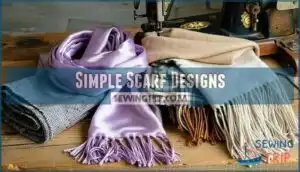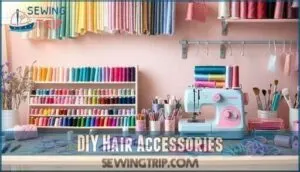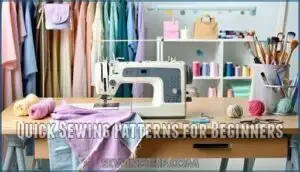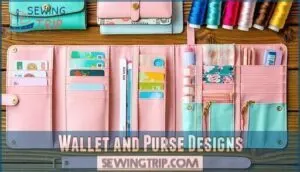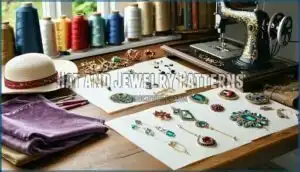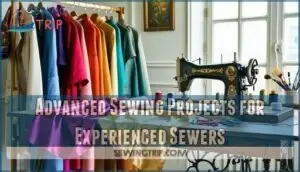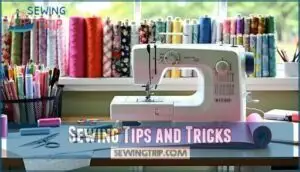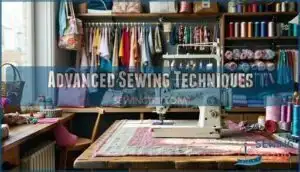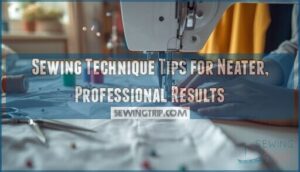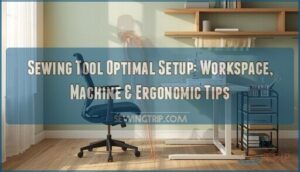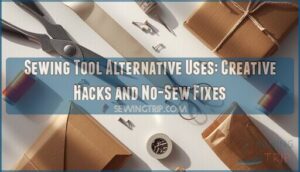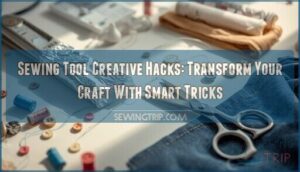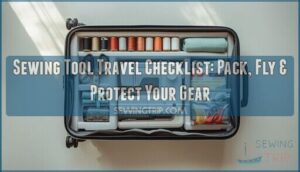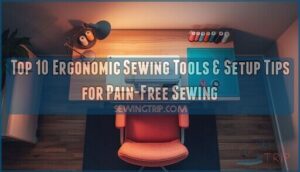This site is supported by our readers. We may earn a commission, at no cost to you, if you purchase through links.
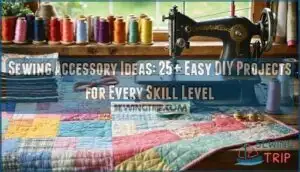
Start with simple scarves using basic stitches, then tackle headbands, hair ties, and fabric flowers.
Create practical wallets, coin purses, and tote bags that’ll save you money.
Try your hand at fabric jewelry, brooches, and statement necklaces for unique pieces.
Cozy hats, mittens, and leg warmers make great cold-weather accessories.
Don’t forget belts, bow ties, and fabric bookmarks for finishing touches.
Whether you’re working with cotton, felt, or repurposed materials, these projects build skills while creating something beautiful.
The secret lies in choosing the right techniques for your skill level to make perfect gifts and transform your wardrobe with unique pieces.
Table Of Contents
Key Takeaways
- Start with beginner-friendly projects – You’ll build confidence quickly by tackling simple items like scarves, hair ties, and tote bags that use basic stitches and forgiving fabrics like cotton.
- Transform your wardrobe affordably – You can create personalized accessories that perfectly match your style while saving money compared to store-bought alternatives.
- Turn mistakes into masterpieces – You’ll discover that customization through fabric choices, embellishments, and personal touches makes each piece uniquely yours, even if it doesn’t turn out as planned.
- Build skills progressively – You’ll master essential techniques like seam finishing and tension adjustment on simple projects before advancing to complex items like structured bags and beaded accessories.
Sewing Accessory Basics
You can transform any basic sewing pattern into a personalized masterpiece by choosing fabrics and trims that reflect your unique style.
Whether you’re making a gift for someone special or treating yourself, customizing accessories like scarves and bags lets you create one-of-a-kind pieces that perfectly match your wardrobe, allowing you to add a personal touch with unique style.
Customization Options
In the context of sewing accessory ideas, customization transforms ordinary pieces into personal statements.
Your fabric choices set the foundation, while trim options add that perfect finishing touch.
Here’s how to make each project uniquely yours:
- Color Schemes – Mix complementary hues or go monochromatic for sophisticated looks
- Embellishments – Add beads, sequins, or vintage buttons for texture and sparkle
- Monogramming – Personalize with initials using embroidery or fabric markers
These customization techniques turn basic sewing patterns for accessories into one-of-a-kind treasures that reflect your style.
Personalized Gift Ideas
DIY gifts let you create treasures that store-bought items can’t match.
Handmade jewelry becomes an instant heirloom, while personalized bags carry memories wherever they go.
Monogrammed accessories show you’ve put thought into every stitch, and photo pouches keep precious moments close.
| Gift Type | Skill Level | Time Required |
|---|---|---|
| Custom Gifts | Beginner | 2-3 hours |
| Handmade Jewelry | Intermediate | 1-2 hours |
| Personalized Bags | All levels | 3-5 hours |
| Monogrammed Accessories | Advanced | 4-6 hours |
Sewing Techniques for Beginners
You’ll master sewing techniques for beginners by starting with basic stitches like straight seams and backstitch.
Choose cotton fabrics for easy handling, and select all-purpose thread that matches your fabric.
Practice seam finishing techniques like zigzag edges to prevent fraying.
Your sewing machine becomes your best friend—learn to adjust tension and stitch length for different projects.
Understanding basic sewing techniques is essential for improving your overall sewing skills.
Easy Sewing Projects
You’ll find beginner-friendly sewing projects don’t require years of experience to create stunning accessories that’ll make your friends wonder where you shop.
Start with simple scarves, hair accessories, and quick patterns that build your confidence while adding personalized touches to your wardrobe.
Simple Scarf Designs
Scarves offer endless creative possibilities with simple construction techniques.
You’ll master basic rectangle designs using just one yard of fabric, then explore infinity loops and blanket-style wraps. These beginner-friendly sewing patterns for scarves let you experiment with different scarf materials and lengths.
- Silk rectangle scarves with rolled hems create elegant accessories perfect for year-round wear
- Cozy fleece infinity scarves require minimal sewing and provide maximum warmth for winter layers
- Fringed cotton scarves showcase decorative edges and customizable tassel ideas for bohemian flair
Your folding techniques and fringe styles will transform basic fabric into statement pieces. These scarf tutorials build confidence while creating practical sewing accessories you’ll actually wear.
For more inspiration, check out various free scarf patterns to enhance your sewing skills.
DIY Hair Accessories
Transform your look with handmade hair accessories that’ll become your signature style.
You’ll need basic supplies like sewing scissors, sewing needles, and fabric scraps to create stunning pieces that rival store-bought options.
| Accessory Type | Difficulty Level |
|---|---|
| Hair Ties | Beginner |
| Headbands | Beginner-Intermediate |
| Hair Clips | Intermediate |
| Barrettes & Bobby Pins | Advanced |
These DIY projects let you customize colors and patterns while building essential sewing skills through practical application.
Quick Sewing Patterns for Beginners
Ready to tackle your first sewing project? Start with simple sewing patterns like sleep masks or infinity scarves—they’re perfect beginner projects that build confidence fast.
These quick patterns feature straight stitches and minimal curves, making sewing basics feel manageable. Choose cotton fabrics for easy handling, and you’ll master DIY sewing fundamentals while creating stylish sewing accessories that actually complement your wardrobe.
Sewing Pattern Ideas
You’ll discover endless possibilities when you explore wallet and purse designs, hat patterns, and jewelry projects that transform basic materials into stunning accessories.
These advanced patterns challenge experienced sewers while offering room for creative customization through fabric choices, embellishments, and personal touches, making them ideal for those seeking to add a personal flair to their work.
Wallet and Purse Designs
Wallet patterns and purse making offer endless creative possibilities for crafting functional accessories that match your personal style.
From minimalist designs to multi-pocket organizers, these projects combine practicality with fashion-forward appeal.
For more inspiration, explore various wallet sewing patterns to find the perfect design.
- Tri-fold wallets with seven pockets maximize organization while maintaining sleek profiles
- Phone wallet designs integrate card slots and cash compartments for all-in-one convenience
- Convertible clutch styles transform from wristlets to crossbody bags with adjustable straps
- Coin purses and zipper pouches utilize fabric scraps for sustainable, quick-sew projects
Hat and Jewelry Patterns
You’ll love exploring hat patterns and jewelry crafts that turn simple materials into statement pieces.
From cozy beanies to elegant brooches, these DIY jewelry and fashion accessories let you master beading techniques and earring crafts.
Hat designs range from slouchy styles to structured caps, while brooch patterns add vintage charm to any outfit.
These sewing patterns for hair accessories and jewelry making projects give you complete creative control.
Advanced Sewing Projects for Experienced Sewers
You’ve mastered the basics—now it’s time to push your skills to the limit.
Advanced sewing projects challenge you with intricate Couture Techniques and complex Fabric Manipulation that’ll make your friends wonder if you’ve secretly opened a boutique. These aren’t your typical weekend projects; they’re textile art pieces that demand precision, patience, and a willingness to embrace beautiful complexity.
- Structured blazers with princess seams – Because nothing says "I’ve got this" like perfectly crafted lapels that could grace a runway
- Beaded evening bags with internal frames – Turn heads with Advanced Embellishments that shimmer and catch light like captured starlight
- Reversible capes with hidden closures – Master the art of invisible construction where every stitch serves both form and function
To take your sewing to the next level, consider exploring advanced sewing techniques that can enhance your skills and creativity.
Sewing Tips and Tricks
You’ll master these sewing fundamentals faster than you think, and they’ll save you countless hours on every project.
Smart fabric choices, the right tools, and knowing how to fix mistakes will transform your sewing from frustrating to fantastic.
Choosing The Right Fabric
Now you’re picking fabric – the foundation that makes or breaks your accessory project! Cotton fabric emerges as the champion for beginners because it’s forgiving, stable, and won’t slip around like a nervous cat.
Here’s your fabric cheat sheet:
| Fabric Type | Best For | Skill Level |
|---|---|---|
| Cotton blends | Bags, headbands, pouches | Beginner |
| Canvas/Denim | Wallets, structured hats | Beginner |
| Linen | Summer scarves, casual bags | Intermediate |
| Silk/Satin | Formal accessories, hair ties | Advanced |
| Knits/Jersey | Stretchy headbands, scrunchies | Intermediate |
Fabric selection depends on your project’s purpose. Medium-weight fabrics (150-250gsm) offer that sweet spot between durability and workability. Thread counts matter too – higher counts mean smoother fabric texture and better drape.
Always pre-wash your sewing fabrics to prevent shrinkage surprises later! Understanding cotton fabric properties is essential for making informed decisions about your sewing projects.
Essential Sewing Tools and Supplies
Building your sewing arsenal doesn’t have to break the bank. Smart investments in quality tools will transform your crafting game and save you headaches down the road.
Must-Have Tools for Every Sewing Kit:
- Sewing Machines – Choose a reliable model with adjustable stitch length and zigzag capabilities
- Rotary Cutters – These ergonomic heroes slice through fabric layers faster than traditional scissors
- Measuring Tools – Accurate rulers, seam gauges, and flexible tape measures guarantee perfect fits
Quality sewing needles and thread types matter more than you’d think. Universal needles work for most projects, while specialized thread creates stronger seams. Don’t forget essential sewing notions like pins, seam rippers, and fabric markers. These basic sewing supplies and accessories will handle 90% of your accessory projects.
Understanding essential sewing tools is vital for any sewing enthusiast to produce high-quality work.
Troubleshooting Common Sewing Mistakes
Even skilled sewers occasionally face Thread Breakage and Tension Problems that can derail projects.
Check your needle first—dull needles cause Fabric Distortion and Seam Issues.
For Bobbin Trouble, make certain it’s properly wound and inserted.
These sewing troubleshooting tips prevent common sewing mistakes: adjust tension gradually, use quality thread, and keep your machine clean for smooth stitching.
Advanced Sewing Techniques
You’re ready to tackle sophisticated projects that’ll transform discarded items into stunning accessories while mastering professional-grade techniques.
These advanced methods let you create one-of-a-kind pieces using specialty fabrics, custom embellishments, and creative upcycling approaches that’ll have everyone asking where you bought your amazing accessories, utilizing professional-grade techniques.
Upcycling Old Clothing Into New Accessories
Transform your worn-out wardrobe into trendy DIY accessories through creative upcycling!
Old jeans become sturdy tote bags, while vintage sweaters turn into cozy headbands.
This sustainable style approach gives tired clothing new life as unique sewing accessories.
Repurposed fashion isn’t just eco-friendly – it’s your chance to create one-of-a-kind pieces that tell your story, with a focus on sustainable style.
Creating Unique Embellishments and Trims
Ready to take your sewing embellishments to the next level? Embellishment Ideas aren’t just about buying fancy sewing notions—you can create stunning Trim Designs that’ll make store-bought versions look basic.
Here’s your creative toolkit:
- Fabric Painting combined with Applique Techniques for one-of-a-kind motifs
- Bead Work layered with embroidery for dimensional texture
- Custom trim ideas using fabric selection scraps and decorative stitching
Mix techniques like a boss—your sewing embellishments will become signature pieces that scream "handmade with love.
Mastering advanced embroidery techniques can elevate your designs with intricate stitches and textures.
Sewing With Specialized Fabrics and Materials
Working with cork fabric, mesh materials, and natural fibers opens up exciting eco-friendly possibilities for your accessories.
These sustainable textiles demand specialized techniques – use clips instead of pins for cork, adjust stitch lengths for mesh, and choose appropriate needles for each material.
Whether you’re crafting with silk, leather, fleece, or knit fabric, matching your tools to the textile guarantees professional results every time, and using the right techniques with materials like cork and mesh can lead to highly sustainable outcomes.
Frequently Asked Questions (FAQs)
What can you do with sewing accessories?
Plain accessories become stunning statements when you customize them with fabric, trim, and embellishments. You’ll create unique gifts, personalize your style, and transform basic items into signature pieces.
How do I choose the right sewing accessories?
Consider your skill level first—beginners should start with cotton fabrics and simple tools like sharp scissors and quality thread.
Match accessories to your projects: zippers for bags, elastic for headbands, buttons for closures.
Choose colors and patterns that complement your style and wardrobe for cohesive results.
How many easy accessories to sew?
Most sewing tutorials offer 46 easy-to-sew accessory patterns.
You’ll find everything from scrunchies to tote bags, perfect for building your skills.
Start with straight-line projects like bookmarks or coffee cozies before tackling curves.
Why are accessories fun to sew?
You’ll love how accessories let you experiment with bold colors and trendy patterns without committing to a whole garment.
They’re quick wins that build your confidence while creating personalized pieces that perfectly match your style.
What are some easy sewing projects?
Breaking the creative ice with simple projects builds confidence quickly.
Start with scrunchies, sleep masks, or tote bags—they’re forgiving and rewarding.
You’ll master straight stitching while creating stylish accessories you’ll actually use, which can help you build confidence.
Can You Make your own accessories?
Yes, you can absolutely make your own accessories.
It’s surprisingly easy and totally rewarding.
Start with simple projects like scrunchies, headbands, or tote bags using basic fabrics and trims to create personalized pieces.
What is the most profitable thing to sew?
High-margin accessories like bags, wallets, and hair accessories offer the best profit potential. You’ll maximize earnings by choosing quality fabrics, efficient patterns, and targeting gift markets during holidays.
What are must haves for sewing?
You’ll need a reliable sewing machine, sharp fabric scissors, quality thread, measuring tape, pins, seam ripper, and good lighting. These basics let you tackle most projects confidently.
What is the easiest item to sew?
Like baby steps before a marathon, start with straight-line projects that build your confidence.
Bookmarks, coffee cozies, and simple tote bags are perfect beginner wins—they’re forgiving, quick, and you’ll actually use them, making them great beginner wins.
What to sew when you don’t know what to sew?
Break creative block by sewing practical items you’ll actually use: scrunchies, coffee cozies, tote bags, or sleep masks. Start with simple straight-line projects that build confidence and skills.
Conclusion
Like seeds sewn into fabric, these sewing accessory ideas will bloom into treasured pieces that define your personal style.
You’ve discovered projects ranging from beginner-friendly scarves to advanced embellishments, each building your confidence and skill set.
Whether you’re crafting heartfelt gifts or revitalizing your wardrobe, these versatile patterns offer endless creative possibilities.
Start with simple projects, then challenge yourself with complex designs.
Remember, every expert seamstress began with a single stitch.
Your journey into handmade accessories starts now.
- https://www.bluesusanmakes.com/10-must-have-sewing-tools-easy-sewing/
- https://icansewthis.com/cool-sewing-tools/
- https://madamsew.com/blogs/sewing-blog/4-sewing-tools-you-never-knew-you-needed
- https://mellysews.com/notions/
- https://sewcanshe.com/trendy-accessories-to-sew-for-your-tech-happy-friends-free-sewing-patterns/

